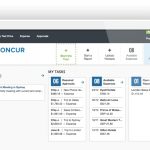Trends in Resource and Inventory Management Technology
As businesses continue to rely on the automation and efficiency of new technologies, many organizations have transformed the way they manage their day-to-day operations. From developments in infrastructure management and interoperational efficiencies to company-wide integration of productivity and time management applications, businesses are discovering the value of investing in the right tools and solutions to scale their organizations effectively.
Image Source: Pixabay
Effective resource and inventory management have always been an important part of developing and sustaining a successful business, and leveraging technology effectively is key to establishing your brand as an innovative disruptor. And as new industry technologies and solutions become available, organizations greatly benefit by allowing their organization to evolve with emerging trends in the following areas:
Intelligent Inventory Management
Over the years, e-commerce has become an important part of the retail industry as a whole. Today, omnichannel selling across multiple marketplaces has become a standard way of doing business for both independent wholesalers and distributors, as well as many big-box retailers.
But the need to manage operations across multiple distribution centers and fulfillment centers have created demand for better inventory solutions. Further, when it comes to international expansion and running global operations, the need for better visibility in the entire distribution chain is critical.
Now, through unified dashboards and intelligent inventory management solutions, businesses can manage their virtual warehouses across multiple supply chains with unparalleled transparency. This helps operations teams stay on top of their inventory requirements regardless of the amount of movement in and out of facilities, as well as create better processes for order management and returns processing.
By using advanced data integrations, businesses are able to benefit from AI-driven inventory recommendations and smart forecasting capabilities that help to avoid stockouts and improve revenue performance.
Barcode Scanners and Hardware
Another method being used for easier inventory tracking and efficiency is barcode scanning. Barcode inventory systems combine the use of infrared scanners, printers, and computer software to automate the manual tracking of product movement in and out of facilities. This added efficiency not only maximizes productivity in warehouses and distribution centers, but it also helps to significantly cut down on shipping errors.
While barcode scanning has been around for quite some time, the technology has advanced considerably over the years, enabling more information to be stored and accessed through new computer and mobile software. With the use of 2D barcodes, customers and logistics companies can save and share better information about packages such as pack quantities, bin locations, serial numbers, product descriptions, and more. This leads to better operational efficiency when transferring stock from one warehouse to the next, as well as providing a better user experience for the customer.
AI-Driven Automation
A new age of automation has emerged over the past few years, and now organizations are taking advantage of the many benefits that artificial intelligence can bring to their businesses. Companies like Amazon have pioneered the use of robots and drones in their operations to reduce shipping costs, lead times, and overall business overhead. By utilizing self-sufficient warehouse drones in their operations, large-scale distribution centers are able to run their operations 24-7 and significantly improve their productivity levels. Now, in nearly every industry AI technology has been introduced in order to drive digital transformations and future-proof business models.
In manufacturing and logistics, however, AI technology isn’t just segmented to robotics. Production planning and factory scheduling are now being guided by AI-driven tools. These solutions help operations teams execute large-scale analysis of operations data, allowing better demand forecasting and actionable insights to make better-informed decisions about the business.
Day Forward Scanning
Another important strategy being adopted by organizations transitioning from their legacy systems and processes is day forward scanning. Day forward scanning is a strategy that enables organizations to transfer seamlessly from paper-based document storage systems to electronic document management solutions. This is most often achieved through the use of service providers who manage the process of scanning, indexing, and storing company documents into a document imaging system.
There are a variety of benefits that day forward scanning provides to growing organizations. First off, the management of digital files is much less cumbersome for employees than managing paper files and makes record-keeping much more efficient. Digital record-keeping can also make a significant positive impact on company budgets and operating expenses by eliminating unnecessary expenses on print services and supplies.
Resource Management Solutions
With most businesses looking to scale while wishing to remain agile to changing market conditions, organizations have a heightened focus on optimizing the management of their internal resources. More than just looking at finances and profitability, however, organizations are investing in solutions to help identify inefficiencies across their entire infrastructure. This includes the allocation of labor and equipment budgets as well as analyzing energy consumption, productivity levels, management expertise, and overall workplace morale.
For most business owners, resource management begins by creating a strategy around resource planning and leveling. In order to carry this out effectively, there are now a number of tools and solutions available to help. Resource management software gives managers the ability to allocate their resources more effectively by benchmarking and tracking resource needs across different projects and teams to ensure tasks are being prioritized appropriately and completed on time. These solutions not only help to allocate the right resources at the right time but also to avoid resource overallocation.
Software as a Service
Growing a business can present a number of challenges, but the one that is most often felt is an inability to scale IT and operational processes as the demands of the business increase. Managing IT teams and in-house applications and services can be quite demanding on both employee bandwidths and overall business expenses. When capacities are reached and businesses need to adopt newer technologies and processes, the expenses and lead times to develop can be difficult to manage and can lead to loss of productivity, business efficiency, and revenue.
In answer to these difficulties, more and more businesses are investing in software-as-a-service (SaaS) offerings to reduce their total operating expenses and provide better flexibility when scaling their infrastructures. SaaS software is offered on a month-by-month basis and typically require little upfront investment and inexpensive hardware to operate. As part of their overall service package, companies get access to the latest technologies and industry capabilities and are able to scale operations effectively.
New business solutions provide advancements for organizations in several ways including the optimization of their supply chain processes and resource management. By staying up-to-date with these emerging trends and keeping your business agile, you can improve your interdepartmental efficiency while reducing operating expenses and maximizing growth.

















